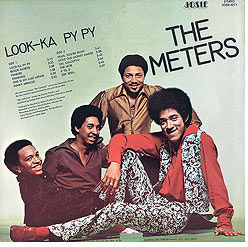Great Wall Street Journal Article about the Meters
Tuesday's (May 24) edition of the Wall Street Journal has a great article about The Meters ("The Original Meters" as Ziggy always refers to them), and how they set the standard for so much great music that followed, from jam bands like the Radiators and Phish, to rappers like L.L. Cool J and Run-DMC (who sampled their music). Too bad we missed their reunion this year. I saw them in 2000 at the Warfield when they had their last reunion, but the Warfield is a crummy venue, so it wasn't as fun as it should have been. The journal quotes Art Neville as saying, during their reunion performance this year, "We may be a little older and a little fatter, but we're still black and we're still funky!" How true!!! Since the site is subscription-only, here's an excerpt. (Btw, if you're gonna pay for any subscription content on the web, the Journal is a great choice: great reporting and incredible range of coverage and original content. The only downside is the crummy editorial page, which is full of right wing nutcases). That the Meters came to be the Lost Tribe of Funk speaks to how music business success can be fleeting, and often band-splintering. In their heyday, they never cracked the charts with the consistency of outfits like Earth, Wind & Fire; their eight-year run was not long enough to earn them the seniority of James Brown or George Clinton. Yet as these more celebrated funk founders attest, the Meters stood out from the rest. "To us, the only funk band around was the Meters," Mr. Clinton says of his early days in the late '60s, when he was molding the Parliament/Funkadelic family of bands. "Before I got with James Brown, they were like the funkiest cats to ever hit the planet," says bassist Bootsy Collins, whose stints with Messrs. Brown and Clinton preceded his own legendary career. "The Meters were different from other funk groups, because they were more like a band...and the drummer -- good Lord!" "I first heard the Meters in the early '70s," recalls Earth, Wind & Fire leader Maurice White. "Everybody else was staying right to the beat, but they had a New Orleans flair....They made a really big sound for four guys." The Meters did what other funk bands of their era could not do: playing a little behind the beat, dropping unexpected spaces into the rhythm that created an altogether surprising, foot-elevating effect. Meters bassist George Porter calls it "our New Orleans 'pocket' -- it was a little more syncopated and probably what made it harder to lock down than [the music of] George Clinton and James and all of those." Mr. Porter is one of four childhood friends from the same New Orleans neighborhood (keyboardist Art Neville, guitarist Leo Nocentelli and drummer Joseph "Zigaboo" Modeliste are the others) who banded together in the late '60s, forced to limit the lineup to a simple quartet by the tight confines of the French Quarter bar that hired them. Over a two-year run, the band developed a loose, economic approach that was heavily swayed by the street-parade rhythms peculiar to their hometown, and built from the rhythm up. Says Mr. Neville, the eldest of the group: "See, when we started out we didn't know anything about music. We just enjoyed playing. But drummers from New Orleans -- there's some kind of little edge there that I can't explain. The drummer was the trick -- Zigaboo." The drummer prefers to share the credit. "It wasn't really me," says Mr. Modeliste. "The band said 'OK, you lay down this drum thing, and we'll compose the music to fit.' They composed the music to the drumbeats. That was the formula that was successful for us for a long time."
So now you know why this blog is named what it is. :)
Swami


No comments:
Post a Comment